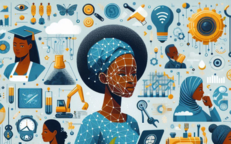Empowering Africa’s Future: Curbing Child Labour In Africa Using Blockchain Technology
This is the 18th post in a blog series to be published in 2023 by the APET Secretariat on behalf of the AU High-Level Panel on Emerging Technologies (APET) and the Calestous Juma Executive Dialogues (CJED)
Child labour, human trafficking, and modern slavery are grave global issues, with the latter being most prevalent in developing countries. Rather unfortunately, Africa bears the highest burden, with an astounding number of child labourers. An estimated 72.1 million children are engaged in child labour, with 31.5 million children involved in hazardous work.[1] This does not only hamper children’s physical and mental development, but also robs them of their childhood, potential, and dignity. Moreover, it obstructs their access to education and poses various dangers to their mental, physical, social, and moral well-being.[2]
According to the African Charter on the Rights and Welfare of the Child, a child is defined as an individual below the age of 18.[3] Child labour in Africa is primarily driven by factors such as poverty, natural disasters, chronic emergencies, famine, conflict, corruption, and the demand for low-cost and submissive labour. The most severe forms of child labour encompass slavery, child trafficking, coerced child prostitution, illicit practices such as drug peddling, and hazardous labour involving the use of perilous machinery.
In Africa, a staggering 85% of all child labour cases amounting to 61.4 million children are found in the agricultural sector. This industry subjects child labourers to tasks such as cattle herding, both commercial and subsistence farming. These are often perilous due to the demanding nature of the work and the challenging working conditions. The remaining African children involved in child labour are distributed across other industries, with 8.1 million (11%) working in the services industry, while 2.7 million (4%) employed in other industries.
A significant number of child labourers receive no remuneration at all, with many children being involved in labour within their family farms or businesses, rather than being employed by external entities. The impact of child labour on children varies depending on the economic sector they are employed in. These innocent children may endure long-term health issues including malnutrition, chemical exposure, abuse, injuries, fatigue, and psychological trauma.[4]
The African Union (AU) has made a resolute commitment to eliminate child labour and combat human trafficking and exploitation through the adoption of various frameworks. Among these crucial frameworks is the African Union Ten-Year Action Plan on Eradication of Child Labour, Forced Labour, Human Trafficking and Modern Slavery in Africa (2020-2030). This blueprint Action Plan serves as an immediate empowering guide, enlisting AU institutions, Member States, Regional Economic Communities (RECs), and other stakeholders to mobilise efforts and accelerate progress towards achieving the AU Agenda 2063 and target 8.7 of the Sustainable Development Goals, SDGs. The goal is to completely abolish forced labour, human trafficking, and modern slavery, with child labour being halted by 2025.
Focused on initiatives with a high potential for swift impact, the Action Plan delineates essential implementation responsibilities at the national, regional, and continental levels. Through these concerted efforts, the AU seeks to protect vulnerable populations and ensure a future free from exploitative practices on the African continent.[5] However, despite the African Union Ten-Year Action Plan, child labour and trafficking in Africa have increased since 2016. According to the International Labour Organization (ILO), Africa has 72.1 million child labourers, constituting one-fifth of the global total. Factors like poverty, conflict, and climate change contribute to this rise. One of the contributing factors to this concerning trend is the incomplete implementation of the Action Plan, resulting in gaps in enforcement and impact. Addressing this issue requires stronger implementation, increased political will, and resources. Tackling root causes such as poverty, conflict, and climate change is critical. With 31.5 million children in hazardous work and 1.2 million victims of trafficking, this alarming trend should be addressed urgently through collaborative efforts to and ensure a brighter future for Africa's children.
The AU High-Level Panel on Emerging Technologies recognises the immense potential of blockchain technology in achieving the goals of the African Union Ten-Year Action Plan on Eradication of Child Labour, Forced Labour, Human Trafficking, and Modern Slavery in Africa (2020-2030). The panel asserts that by harnessing blockchain, significant strides can be made in eradicating and preventing child labour in Africa.
One of the key strengths of blockchain is its decentralised nature, ensuring that transactions are carried out without any data tampering, thereby, ensuring security, permanence, transparency, and audibility through recording in an immutable ledger.[6] This makes it particularly well-suited for tracking and tracing the physical supply chain. By utilising blockchain, companies, financiers, and customers can precisely identify a material's origin and trace its journey through the various stages of processing, from raw materials to finished products. This level of transparency empowers stakeholders to detect any potential involvement of child labour in the production of goods. Furthermore, the unchangeable identity of the information uploaded to the blockchain allows for comprehensive evaluation at each stage of production.
Conventional survey and national accounting methods fall short in tracking the origins of finished products and their components. To achieve the desired level of transparency, statistics should not only be collected in the consumption market but also throughout the entire supply chain. Blockchain offers a viable solution for this complex task. With blockchain, it becomes feasible to detect child labour at each link in the global supply chain, requiring specific data on child employment within sectors and the interdependence of sectors across nations.[7]
The AU High-Level Panel on Emerging Technologies (APET) strongly urges African countries to invest in collecting more timely and better disaggregated national data through blockchain. This data-driven approach will enhance the analysis of trafficking for forced labour and provide a clearer understanding of the extent and characteristics of child labour in global supply chains. For example, blockchain technology offers a powerful solution in combatting child labour in the cocoa industry. Farmers can use blockchain to record the age and working hours of their workers, while cocoa traders can track the movement of cocoa beans from farm to chocolate factory. Chocolate manufacturers can then verify that the cocoa beans they use were produced without the involvement of child labour. This ensures that cocoa products are ethically sourced, giving consumers peace of mind when purchasing chocolate.
In another notable example, prominent companies such as Ford Motor Company, LG Chem, and Huayou Cobalt have joined forces to implement blockchain technology in the cobalt mining and marketing process in the Democratic Republic of the Congo (DRC). This innovative blockchain-based platform enables monitoring and assessment of every stage of production, from mining in remote Southern Congo, home to most of the world's cobalt reserves, to Asian smelters, refineries, and the global trading market.
The platform securely records essential details such as the mine's name, date and time of mining, quantity, and miner's identity, along with information about the smelter's processing. Being immutable, this data ensures that Ford, LG Chem, and Huayou Cobalt can trace cobalt throughout the supply chain, guaranteeing ethical practices and avoiding child labour or other unethical activities. By providing transparency, traceability, and reducing fraud risks, the blockchain has the potential to revolutionise cobalt mining and marketing, fostering ethical and responsible practices within the industry.
In conclusion, blockchain emerges as a potent tool for eradicating child labour and safeguarding human rights. Through transparent production process for goods and services, it empowers consumers to make informed choices and discourages businesses from resorting to unethical practices such as child labour. Moreover, blockchain's ability to track goods throughout the supply chain enables the identification of specific farms or factories employing child labour, facilitating protective measures and preventing exploitation. While still a relatively new technology, blockchain holds the potential to revolutionise the tracking and tracing of goods and services, ultimately contributing to the elimination of child labour and the protection of human rights.
Featured Bloggers – APET Secretariat
Aggrey Ambali
Justina Dugbazah
Barbara Glover
Bhekani Mbuli
Chifundo Kungade
Nhlawulo Shikwambane
[1] https://www.ilo.org/africa/areas-of-work/child-labour/lang--en/index.htm
[2] https://www.ilo.org/ipec/facts/lang--en/index.htm
[3] https://au.int/sites/default/files/treaties/36804-treaty-african_charter_on_rights_welfare_of_the_child.pdf
[4] https://www.worldvision.ca/stories/child-protection/child-labour-facts-and-how-to-help#:~:text=Generally%2C%20child%20labourers%20can%20suffer,tools%20and%20carry%20heavy%20loads
[5] https://au.int/en/articles/african-union-committed-ending-child-labour-and-other-forms-human-exploitation#:~:text=This%20involves%20ending%20child%20labour,country%2C%20regional%20and%20continental%20levels.
[6] https://pdf.sciencedirectassets.com/
[7] https://mneguidelines.oecd.org/Ending-child-labour-forced-labour-and-human-trafficking-in-global-supply-chains.pdf


